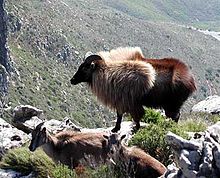Himalayan Tahr
| Himalayan Tahr | ||||||||||||
|---|---|---|---|---|---|---|---|---|---|---|---|---|

Himalayan tahr ( Hemitragus jemlahicus ) |
||||||||||||
| Systematics | ||||||||||||
|
||||||||||||
| Scientific name of the genus | ||||||||||||
| Hemitragus | ||||||||||||
| Hodgson , 1833 | ||||||||||||
| Scientific name of the species | ||||||||||||
| Hemitragus jemlahicus | ||||||||||||
| ( H. Smith , 1826) |

The Himalayan tahr ( Hemitragus jemlahicus ) is a goat-like artifact species that lives in the Himalayan region . Even if the Himalayan tahr was scientifically described as early as the first half of the 19th century, its way of life was only examined in more detail in the course of the 20th century.
features
Himalayan tears are similar to related goats. They have a stocky build with short, strong legs. These animals reach a head trunk length of 90 to 140 centimeters, a shoulder height of 65 to 100 centimeters and a weight of 36 to 90 kilograms. The tail measures 17 centimeters. Adult Himalayan tears can weigh up to 90 kilograms.
The topline is sloping. The fur of the Himalayan tahr is long and shaggy and colored red-brown to gray-brown; characteristic of this species is the thick mane in the neck area, which extends to the front legs. In the summer months their fur is significantly shorter and lighter. The ears are small and pointed, the muzzle, as in all tahrs, hairless. Both sexes have horns. These are curved back and flattened on the sides and can be up to 45 centimeters long. The horns of the females are usually much smaller.
distribution
Himalayan Tahrans live in Asia, their distribution area includes the Himalayan region from Kashmir to western Bhutan . Their habitat are predominantly mountainous areas with forests. In Nepal they occur at altitudes between 2,500 and 4,400 meters, their distribution area extends over several vegetation zones. Their habitat includes evergreen rhododendron forests as well as alpine meadows with dwarf shrubs and grasses.
There is a large, wild-life population on New Zealand's South Island that is also hunted. Smaller, introduced groups of Himalayan tahrs also exist in Canada , the United States, and South Africa .
Way of life
These animals are mainly active in the early morning and late afternoon, during the day they rest in the shelter of rugged rocks or dense vegetation. They are skilled climbers and are considered shy animals. During the winter months they migrate to lower-lying areas. They live together in groups of 2 to 23 animals. These groups either only consist of females and their offspring or can also be mixed-sex groups. Mixed-sex groups are usually larger than all-female groups. Older males are mostly solitary.
The food spectrum of the Tahre is limited. Oak leaves and bamboo play a big role in their diet. To get hold of oak leaves, they occasionally straighten up on their hind legs and bend down one of the branches with one or even both forelegs. In addition, they eat grasses such as grape oats , lemongrass, and Arundinella nepalensis . They also eat the shoots of bird knotweed and leucosceptrum as well as flowers of Daphne bhoula and lichens.
In the mating season between October and January there are fights between the males for the mating privilege, but these are less intense compared to other ungulates. After a gestation period of around seven months, the female gives birth to one or two young. These are weaned after six months and are sexually mature at two to three years of age.
Himalayan tears and people
The Himalayan Tahr has a relatively large range, but is threatened by the increasing destruction of its habitat and hunting. The IUCN lists it as " near threatened ".
Systematics
The Himalayan tahr was traditionally listed as one of three species of tahr , all of which originally formed the genus Hemitragus ; the other two types are the Nilgiri tahr and the Arabian tahr . According to molecular genetic investigations by Ropiquet and Hassanin 2005, however, the tahre are not very closely related and a common genus cannot therefore be maintained. According to the research, the Himalayan Tahr is a close relative of the goats (genus Capra ).
literature
- Ronald M. Nowak: Walker's Mammals of the World. Johns Hopkins University Press, 1999, ISBN 0-8018-5789-9 .
- A. Ropiquet, A. Hassanin: Molecular evidence for the polyphyly of the genus Hemitragus (Mammalia, Bovidae). In: Molecular Phylogenetics and Evolution. 2005, No. 36 (1), pp. 154-168.
- Tej Kumar Shrestha: Wildlife of Nepal - A Study of Renewable Resources of Nepal Himalayas. Tribhuvan University, Kathmandu 2003, ISBN 99933-59-02-5 .
Web links
- Distribution map, photos and further information
- Hemitragus jemlahicus onthe IUCN Red List of Threatened Species . Retrieved July 22, 2009.
Single receipts
- ↑ a b Shrestha, p. 236.
- ↑ Introduced Ungulates in New Zealand (a) Himalayan Tahr
- ↑ Shrestha, p. 239.
